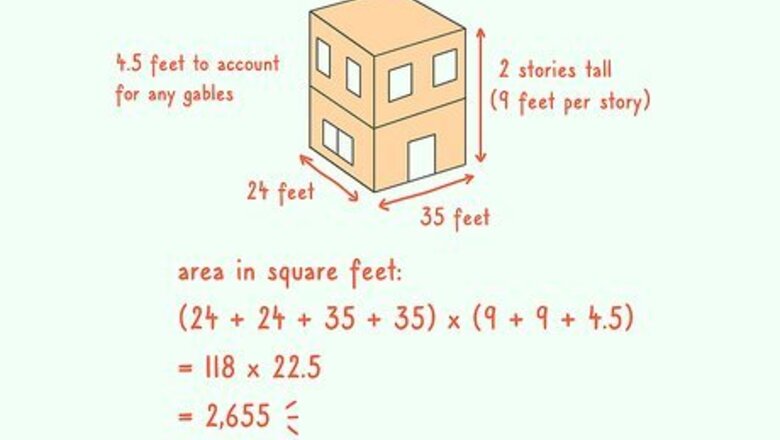
views
Measuring Your Home
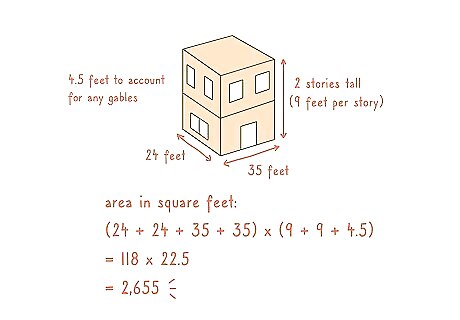
Multiply the house perimeter by the roofline height to measure the exterior. To calculate the area of exterior walls, measure the perimeter of the house, or the combined length of all exterior walls. Exclude porches or other “appendages.” Multiply the perimeter by the height of the roofline, or the spot where the top of an exterior wall meets the roof. If your house has gables (peaked parts of the roof), add half the height of a story to the total roofline height to get a ballpark approximation of the area including gables.Tip: Don’t bother subtracting the area of any doors or windows from your measurement. The extra paint you’ll end up with based on this calculation can be used to cover things like porches, railings, and window frames. Most houses have a height of 9 feet (2.7 m) per story. Add 4.5 feet (1.4 m) to account for any gables. For example, if your house is 24 feet (7.3 m) by 35 feet (11 m) and 2 stories tall, the area in square feet would be (24 + 24 + 35 + 35) x (9 + 9 + 4.5) = 118 x 22.5 = 2,655.
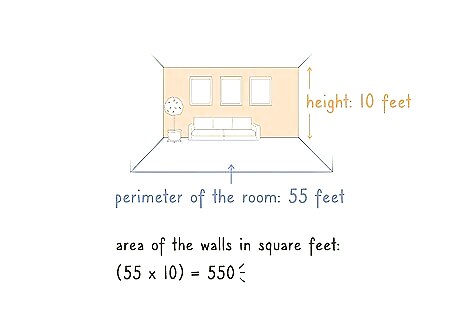
Multiply a room’s perimeter by the ceiling height to find the wall area. To estimate the cost of painting a room, find the total wall area of the room. Measure the perimeter of the room (the combined lengths of all sides of the room) and multiply it by the height of the ceiling. For example, if the perimeter of your room is 55 feet (17 m) and the ceiling is 10 feet (3.0 m) high, the area of the walls is 550 square feet (51 m). If the room has any doors and windows, measure the area of each and subtract it from the wall area for a more accurate estimate. Multiply the length of each door or window by its width to find the area.
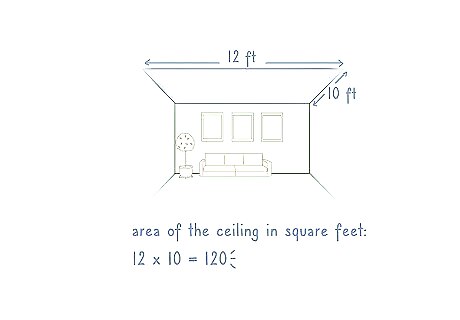
Measure the area of the ceilings if you plan to paint them. If you’re going to paint your ceilings, you’ll need to factor them in as well. Measure the length of the ceiling and multiply it by the width to get the total area. For example, if the ceiling is 12 feet (3.7 m) by 10 feet (3.0 m), the area is 120 square feet (11 m).

Measure any doors, windows, and trim you plan to paint. In addition to the walls and ceilings, you may wish to paint your doors and doorframes as well as other trim, such as baseboards. To save the trouble of measuring each of these individually, you can use these tricks to get a good estimate: Most doors are 21 square feet (2.0 m), so simply multiply that area by the number of doors you plan to paint. Likewise, the average window is 15 square feet (1.4 m). While you won’t be painting the windowpanes, the amount of paint you’d need to cover them should also be roughly how much you’d need to cover the window frames and door frames in a given room. To estimate the area of your baseboards, calculate the perimeter of the room and subtract 3 feet (0.91 m) per door. Multiply that by the trim width of your baseboard (e.g., .5 feet (0.15 m).
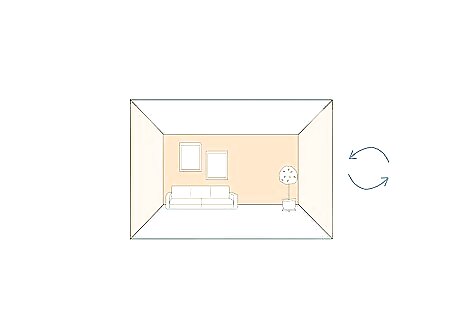
Repeat this process with every room to find the total area. To determine the total square footage you’d like to cover, measure all the surfaces you’d like to paint throughout the entire house, including walls, ceilings, doors, and trim. Add up the results. For example, this might yield a total area of 2,350 square feet (218 m).
Estimating Your DIY Costs
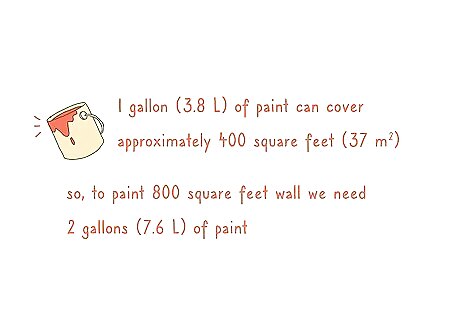
Follow the rule of 1 gallon (3.8 L) of paint per 400 square feet (37 m). While the exact coverage you can expect will vary depending on the kind of paint you’re using and the surface you’re painting on, this is a good rule of thumb. Divide the total number of square feet you have to paint by 400 to determine how many gallons of paint you need. For example, you can cover 850 square feet (79 m) with 2.13 gallons (8.1 L) of paint (or 3 gallons (11 L), rounding up to the nearest gallon). For smaller areas, you can use the rule that 1 US quart (0.95 L) of paint covers 100 square feet (9.3 m). If you need multiple coats of paint, multiply your estimate by the number of coats you plan to use. For example, if you need to use 2 coats of paint in a 400 sq ft (37 m) area, you’ll need 2 gallons (7.6 L) of paint.
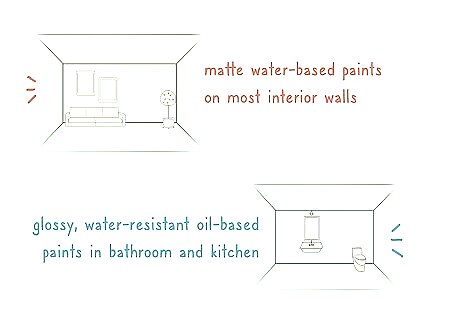
Make a list of the individual types and colors of paint you need. You probably won’t be painting your house all one color, and different surfaces require different types of paint, as well. Before you start budgeting, determine how many different types and colors of paint you will need. Knowing what kinds of paints you’ll be getting will help you calculate your costs more accurately. For example, you might want to use matte water-based paints on most interior walls, but use glossy, water-resistant oil-based paints in your bathroom and kitchen. For exterior surfaces, like your siding or your deck, you’ll need heavy-duty latex paints that can stand up to the elements. Look for a combined paint and primer that will adhere well to most surfaces. You’ll likely want at least one exterior paint color and at least one interior paint color, plus at least one additional color for trim.
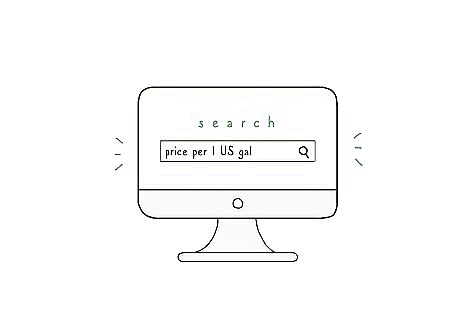
Look up the price per 1 US gal (3.8 L) of the types of paint you want. Most paints cost between $20 and $70 per 1 US gal (3.8 L). Go through the list of paints you want and look up the price for each one.Tip: A high price tag or impressive warranty claim doesn’t necessarily guarantee the best quality. Consumer Reports testing found that several of the longest-lasting exterior paints are in the $30-$40 range.
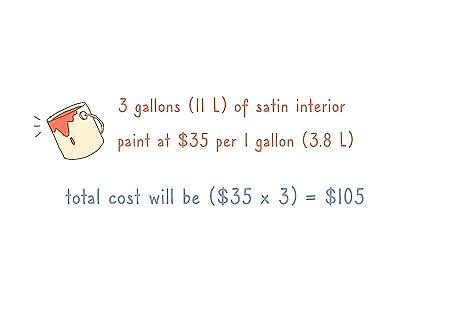
Multiply the price per 1 US gal (3.8 L) by the amount of paint you need. To figure out how much you’ll be spending on paint, look at the amount of paint you need to cover each surface in your home. Break it down by the kind of paint you’ll need for each surface, then multiply the amount of paint needed by the price of the paint. Add all the sums together to get the total price. For example, if you need 3 gallons (11 L) of satin interior paint at $35 per 1 gallon (3.8 L), the cost will be $105.
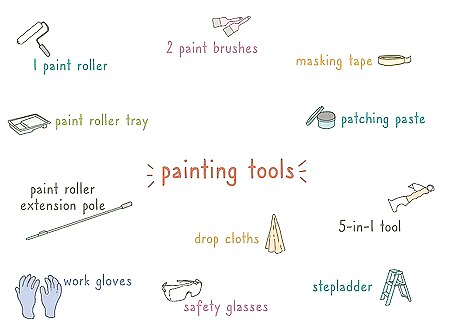
Factor in the cost of painting tools. In addition to paint, you’ll also need to pay for tools, such as brushes, rollers, paint pans, and drop cloths. While the total cost of supplies will vary depending on the size of your house and how elaborate your painting job is going to be, you can expect to pay at least $150. You will likely need: Patching paste A 5-in-1 tool for scraping off paint, removing nails, and taking out old caulk and putty Masking tape for creating clean edges and protecting your trim At least 2 paint brushes At least 1 paint roller A paint roller tray A paint roller extension pole Drop cloths Work gloves Safety glasses A stepladder
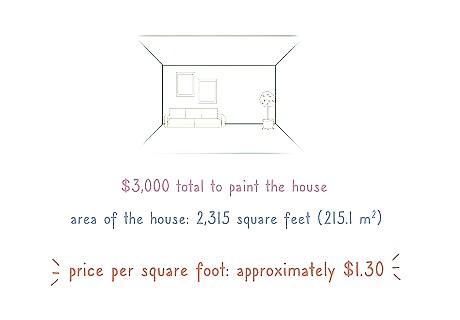
Divide the total cost by the area of your house to estimate price per square foot. Once you have a ballpark estimate of how much you’ll be spending, divide that number by the approximate square footage of your home. Use the total area that you measured while approximating how much paint you’ll need for each part of the house. For example, if you estimated that it will cost about $3,000 total to paint your house, and the area of your house is 2,315 square feet (215.1 m), then the price per square foot for painting your house is approximately $1.30.
Calculating the Costs for a Professional Job

Look up standard painting price ranges for your house size. Use a rough estimate of your house size to get a ballpark idea of how much a professional paint job will cost. Try doing a search online using terms like “painting cost estimate for 2,500 square foot home interior.” Keep in mind that interior painting is typically more expensive than exterior painting due to differences in the type of materials and labor involved.Be aware: Getting your house professionally painted will likely cost roughly 50-60% more than painting it yourself. However, it will also save you a great deal of time and labor. For example, according to the Painting and Decorating Contractors of America, it costs between $3,000 and $5,000 to paint the outside of a 2,500 sq ft (230 m) house, and between $3,750 and $7,500 to paint the interior of a house of the same size. These estimates typically include the costs of materials as well as labor.
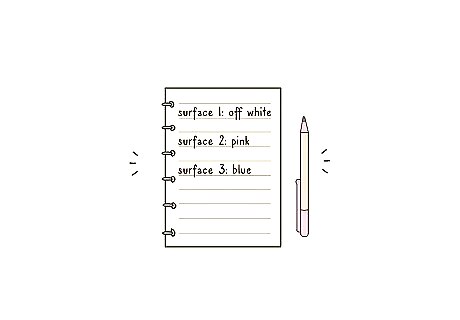
Write down how many surfaces need painting and what colors you want. In addition to looking at how big your house is, consider how you want it painted. Factor in details such as how many colors of paint you want, how many doors, window frames, and other trim elements will need painting, and whether you’ll want the ceilings painted as well. Write down all these details so you can get a more exact price estimate from potential painters. If you’re planning to drastically change the colors of any surfaces, you may need multiple coats of paint to get the color you want.
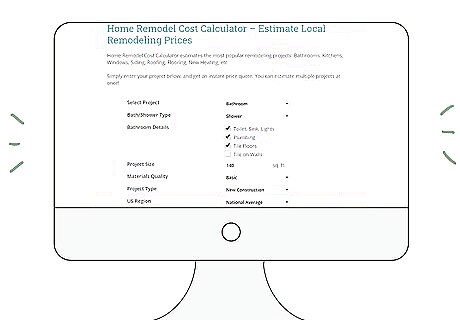
Use a paint cost calculator to get a more detailed estimate. There are a number of painting cost calculators online that can give you a more precise estimate based on the square footage of your home as well as factors like the number of colors you plan to use, the amount of detail work that’s needed, and where you live. Try a calculator like the ones available at http://www.remodelingcalculator.org or on the Home Advisor website. You’ll need to provide information such as the area of your home in square feet, how many doors and windows need to be painted, how many floors your home has, whether or not you want the moldings and ceilings painted, and whether it’s a paint job for a newly constructed home or a renovation on an older one. These calculators include the costs of materials and labor.

Call at least 3 local painters for price estimates. Once you have an idea of the standard price ranges for house painting in your area, you’ll have a better sense of whether a potential painter is offering you a good deal. Do a search for contractors in your area and call up a few of them to get pricing estimates. Compare the estimates you receive and choose the best one. Ask your friends and family for recommendations, or use a crowd-sourced directory like Angie’s List or Yelp to find reviews of painters in your area. Ideally, you should have each potential contractor come to your home so they can assess the job and give you a more accurate estimate. Make sure you provide the square footage of your home as well as other details, like how many doors and windows need to be painted and whether they’ll need to cover or remove old paint.

Ask potential painters for a breakdown of their pricing. Most professional painters will estimate their pricing based on a combination of factors, including the cost of paints and other materials as well as the cost of labor. Work with your painter to get an estimate of how much it will cost to paint your house based on the amount of work they’ll need to do as well as the size of the area they have to cover. Many painters charge about $20 per hour in labor costs. Labor includes not only the time spent painting, but also time spent doing preparatory work such as power washing, scraping away old paint, or taping off areas you want painted in a different color. The total cost will likely be roughly twice the basic cost of materials and labor. This is because your painter may also need to cover the costs of things like marketing, insurance, subcontractors, and other expenses not directly associated with your paint job. They need to factor those things into their prices to make a profit.

Divide the total cost estimate by the square footage of your house. To calculate the price per square foot of a professional paint job, look at the total cost estimate, including materials, labor, and any other fees. Divide this number by the approximate area of your home. For example, perhaps you’ve received an estimate of $6,750 total for the interior and exterior of your 2,500 sq ft (230 m) home. The approximate price per square foot would be $2.70.
















Comments
0 comment